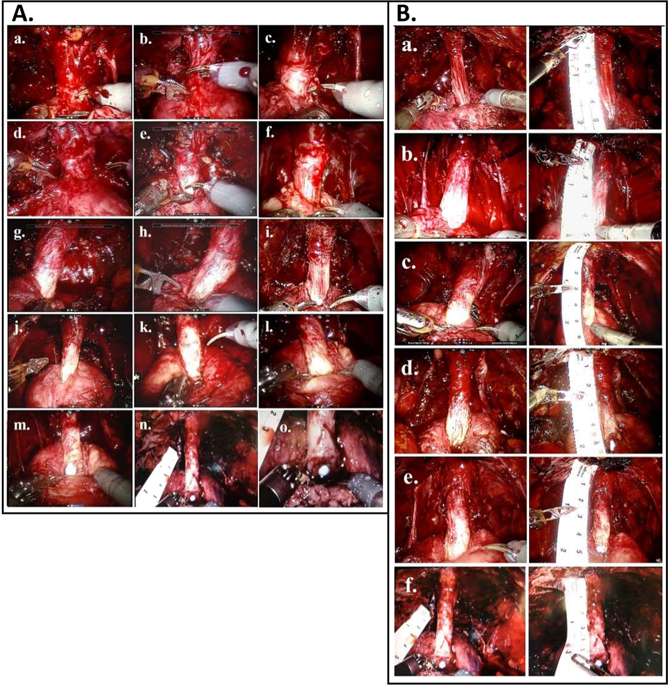当前位置:
X-MOL 学术
›
Prostate Cancer Prostatic. Dis.
›
论文详情
Our official English website, www.x-mol.net, welcomes your
feedback! (Note: you will need to create a separate account there.)
Feasibility and continence outcomes of extended prostatic urethral preservation during robot-assisted radical prostatectomy.
Prostate Cancer and Prostatic Diseases ( IF 5.1 ) Pub Date : 2019-11-07 , DOI: 10.1038/s41391-019-0173-y Luciano A Nunez Bragayrac 1 , Ahmed A Hussein 1 , Kristopher Attwood 2 , Elena Pop 1 , Gaybrielle James 1 , Jennifer Osei 1 , Christine Murekeysoni 1 , Eric C Kauffman 1, 3
Prostate Cancer and Prostatic Diseases ( IF 5.1 ) Pub Date : 2019-11-07 , DOI: 10.1038/s41391-019-0173-y Luciano A Nunez Bragayrac 1 , Ahmed A Hussein 1 , Kristopher Attwood 2 , Elena Pop 1 , Gaybrielle James 1 , Jennifer Osei 1 , Christine Murekeysoni 1 , Eric C Kauffman 1, 3
Affiliation

|
BACKGROUND
The prostatic urethra is conventionally resected during robot-assisted radical prostatectomy (RARP). We describe the technical feasibility and urinary continence outcomes of extended prostatic urethral preservation (EPUP) during RARP.
METHODS
A single surgeon at a National Comprehensive Cancer Network institute performed 48 consecutive RARP operations using EPUP from March 2014 to March 2016, during which time 177 conventional non-EPUP RARP operations were performed by other surgeons. Prior to this period, the EPUP surgeon had performed 17 non-EPUP RARP operations over 15 months. Total intracorporeal urethral length (IUL) preserved during EPUP was measured intraoperatively. Associations of EPUP and IUL with continence recovery rates and/or times were tested in Fisher's exact and log rank univariate analyses and Cox logistic regression multivariable analyses.
RESULTS
Median IUL preserved during EPUP was 4.0 cm (range 2.5-6.0 cm), and urethral dissections typically spanned the prostatic apex to mid-gland or base. Seven-week continence rates were significantly higher with versus without EPUP. EPUP patient rates of using 0 or 0-1 pads per day immediately after catheter removal were 19% and 35%, respectively. These rates increased significantly (53% and 76%, respectively), as did the IUL preserved (median 5.0 cm), among more recent EPUP patients (n = 17), which suggested a learning curve. In multivariable analyses including all patients, an EPUP approach was an independent predictor of faster continence recovery. In multivariable analyses of the EPUP subset, a longer IUL preserved was independently associated with faster continence recovery. No EPUP patient had a urethral fossa positive margin, and apical positive margins were similarly infrequent among EPUP and non-EPUP patients.
CONCLUSIONS
EPUP is technically feasible during RARP and associated with faster continence recovery. Future investigation into the generalizability of these findings and the oncologic safety of EPUP is warranted.
中文翻译:

机器人辅助根治性前列腺切除术中延长前列腺尿道保留的可行性和控制结果。
背景技术通常在机器人辅助的根治性前列腺切除术(RARP)期间切除前列腺尿道。我们描述了 RARP 期间延长前列腺尿道保留 (EPUP) 的技术可行性和尿控结果。方法 2014 年 3 月至 2016 年 3 月,国家综合癌症网络研究所的一名外科医生使用 EPUP 连续进行了 48 次 RARP 手术,在此期间,其他外科医生进行了 177 次常规非 EPUP RARP 手术。在此之前,EPUP 外科医生在 15 个月内进行了 17 次非 EPUP RARP 手术。EPUP 期间保存的体内尿道总长度 (IUL) 在术中测量。EPUP 和 IUL 与失禁恢复率和/或时间的关联在 Fisher' 精确和对数秩单变量分析和 Cox 逻辑回归多变量分析。结果 EPUP 期间保留的中位 IUL 为 4.0 厘米(范围 2.5-6.0 厘米),尿道解剖通常跨越前列腺尖部到中腺或基部。与不使用 EPUP 相比,7 周的失禁率显着更高。拔除导管后立即使用 0 或 0-1 个电极垫的 EPUP 患者率分别为 19% 和 35%。在最近的 EPUP 患者(n = 17)中,这些比率显着增加(分别为 53% 和 76%),IUL 保留(中位数 5.0 cm)也是如此,这表明存在学习曲线。在包括所有患者的多变量分析中,EPUP 方法是更快的失禁恢复的独立预测因子。在 EPUP 子集的多变量分析中,较长的 IUL 保留与较快的失禁恢复独立相关。没有 EPUP 患者具有尿道窝阳性切缘,并且在 EPUP 和非 EPUP 患者中,顶端阳性切缘同样罕见。结论 EPUP 在 RARP 期间在技术上是可行的,并且与更快的失禁恢复相关。有必要进一步研究这些发现的普遍性和 EPUP 的肿瘤学安全性。
更新日期:2019-11-07
中文翻译:

机器人辅助根治性前列腺切除术中延长前列腺尿道保留的可行性和控制结果。
背景技术通常在机器人辅助的根治性前列腺切除术(RARP)期间切除前列腺尿道。我们描述了 RARP 期间延长前列腺尿道保留 (EPUP) 的技术可行性和尿控结果。方法 2014 年 3 月至 2016 年 3 月,国家综合癌症网络研究所的一名外科医生使用 EPUP 连续进行了 48 次 RARP 手术,在此期间,其他外科医生进行了 177 次常规非 EPUP RARP 手术。在此之前,EPUP 外科医生在 15 个月内进行了 17 次非 EPUP RARP 手术。EPUP 期间保存的体内尿道总长度 (IUL) 在术中测量。EPUP 和 IUL 与失禁恢复率和/或时间的关联在 Fisher' 精确和对数秩单变量分析和 Cox 逻辑回归多变量分析。结果 EPUP 期间保留的中位 IUL 为 4.0 厘米(范围 2.5-6.0 厘米),尿道解剖通常跨越前列腺尖部到中腺或基部。与不使用 EPUP 相比,7 周的失禁率显着更高。拔除导管后立即使用 0 或 0-1 个电极垫的 EPUP 患者率分别为 19% 和 35%。在最近的 EPUP 患者(n = 17)中,这些比率显着增加(分别为 53% 和 76%),IUL 保留(中位数 5.0 cm)也是如此,这表明存在学习曲线。在包括所有患者的多变量分析中,EPUP 方法是更快的失禁恢复的独立预测因子。在 EPUP 子集的多变量分析中,较长的 IUL 保留与较快的失禁恢复独立相关。没有 EPUP 患者具有尿道窝阳性切缘,并且在 EPUP 和非 EPUP 患者中,顶端阳性切缘同样罕见。结论 EPUP 在 RARP 期间在技术上是可行的,并且与更快的失禁恢复相关。有必要进一步研究这些发现的普遍性和 EPUP 的肿瘤学安全性。











































 京公网安备 11010802027423号
京公网安备 11010802027423号